Game Designer Between Two Cities
A family board game about building cities may not sound very unique. Especially since our last two game reviews have been about city-building games.
Yet, if you've seen our recent reviews of Machi Koro and Dice City, you'll have noticed that even though the themes are similar, the game experiences are very different.
The same absolutely holds true here as well.
Between Two Cities provides a completely different game play experience than either of those other two games. And not just because Between Two Cities doesn't have dice.
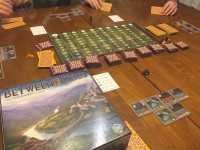
Between Two Cities is a tile-laying game that plays quickly, requires coordination with your neighbor, and allows up to 7 players to join in the fun.
For the namesake, maybe we should have reviewed Between Two Cities in between our recent reviews of those two city-building dice games.
However, we've chosen to review Between Two Cities last among the three because, as you know, "last the best of all the game".
How to Play
Between Two Cities is a very simple and fun game to play.
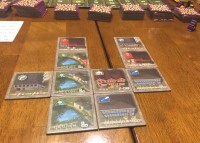
In the game, each player constructs two 4×4 tile cities made out of different types of building tiles. Each building type scores in a unique manner depending on how many and where they're placed in the city.
However, players don't construct their own cities. Instead, each city is built between two players. The neighboring players jointly construct the cities between them during the game.
It's definitely a unique tile-laying, city-building game and one we really enjoy.
Take a look for yourself…
Set Up
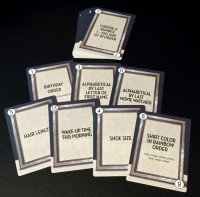
To begin, players are seated around the table according to a randomly selected category card. The card may say to sit "Alphabetical by city of birth" or by "Shoe size". While it may not really be necessary to randomize your seating like this, it's a fun addition to the game for mixing up who people are sitting next to.
Between each player, place one City token. This indicates where the city between each player will be built. The matching City token for each city will be placed next to the scoreboard.
Then shuffle all the building tiles and place them in face-down stacks next to the scoreboard.
Gameplay
The game is played in 3 rounds.
Round 1:
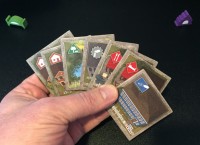
At the start of the first round, players each simultaneously draw 7 single building tiles to form their hand. From those 7 tiles, each will choose 2 tiles to play. They then place the remaining 5 tiles under the city token to their left. This signals that they're ready for the next step.
Once everyone has selected their 2 tiles, they simultaneously reveal them face-up in front of them.
Each player must place 1 building tile in the city to their left and 1 building tile in the city to their right. To do so, players discuss with their neighboring players where to best place their chosen tiles.
After discussing the options, players place their tiles in the city of their choice. All tiles must be oriented in the same direction and must be placed adjacent to at least one other tile in that city.
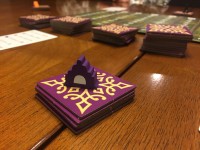
Tiles must also be placed so that the final city is a 4×4 square.
If there is more than one tile under the city token to a player's right, they pick up those tiles and repeat the process. For example, they'll pick up the 5 tiles under the city token, select 2 to play, and place the remaining 3 under the city token to their left. Once again players would discuss options with their neighbors on their chosen tiles and place one in each city.
At the end of the first round, each city will consist of 6 building tiles.
Round 2:
For the second round, players each simultaneously draw 3 duplex building tiles (the double tiles). From those 3 tiles, each will choose 2 tiles to play.
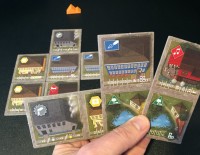
Once everyone has chosen their 2 tiles they likewise reveal them and discuss the options with their neighboring players to determine in which city and where to place each tile.
Each player again must place 1 tile in the city to their left and 1 tile in the city on their right. Thus, each city will have 2 duplex city tiles added this round.
The duplex tiles act like 2 building tiles connected to each other and some are oriented vertically and some horizontally. In either case, the orientation of the buildings must match the orientation of the other tiles already in the city and cannot exceed the boundary limits of the 4×4 city grid.
Round 3:
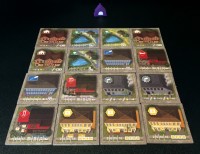
The third round is exactly like the first round with one exception. Instead of passing the remaining tiles to the left, they will be passed to the right.
At the end of round 3, all cities will consist of 16 building tiles forming a 4×4 grid.
End Game Scoring
Once all cities are complete, players total up the score of each city and move the corresponding city token on the scoreboard accordingly (Scoring Details below). City scores are then compared to determine the winner.
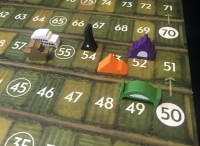
The condition for winning Between Two Cities is very unique.
It's not as simple as "the highest city score wins".
Instead, a player's final score is the lower score of their two cities.
Then the player with the highest final score is the winner!
Thus, a player must get the highest low score in order to win.
As an example, suppose in a 4-player game, the final city scores going around the table clockwise are:
Player 1 cities – 51 & 48
Player 2 cities – 48 & 60
Player 3 cities – 60 & 54
Player 4 cities – 54 & 51
Player 1's final score will be 48
Player 2's final score will be 48
Player 3's final score will be 54
Player 4's final score will be 51
So Player 3 wins the game!
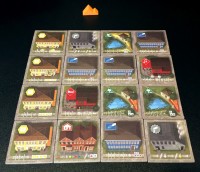
Even though Player 2 had a great scoring city with Player 3 (60 points), Player 2's other city only scored 48 points (his lowest scoring city being his final score). So instead Player 2 and Player 1 tie for last place.
Scoring Details
Now that you know what you're shooting for, it's important to know how each building type scores.
The best way to do the final scoring is to score all cities one building type at a time. For example, start with scoring Shops, and then move on to Factories, etc. Each player can determine the score of the city to their left and move that city token that number of spaces on the scoreboard.
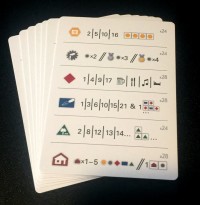
The way each building type scores is clearly indicated at the bottom of each tile as well as on the handy score reference cards that each player has.
SHOPS (yellow)
Shops score when connected in a straight line either horizontally or vertically. Depending on how many shops are in a straight line, the city scores the indicated number of points. For example, one shop will score 2 points whereas 2 connected Shops will score 5 points and 3 connected shops will score 10 points, etc.
FACTORIES (grey)
The city (or cities if tied) with the most Factories will score 4 points for each Factory in the city. The city with the second most Factories will score 3 points per Factory. All other cities will score 2 points for each Factory.
TAVERNS (red)
There are four different Tavern tiles, each with a different icon inside a diamond. Taverns score 1 point for one in a city, 4 points for two different Taverns, 9 points for three different Taverns, and 17 for all four Tavern types in a city. Each set of Taverns is scored differently.
OFFICES (blue)
Offices score based on how many are in each city, regardless of location or adjacency. In addition, each Office gets +1 point if it is adjacent to at least one Tavern. For example, if there are 3 Offices in a city and 2 of them are next to a Tavern, the total score for Offices will be 8 points for that city.
PARKS (green)
Parks are scored in groups of one or more connected park tiles. One park tile is worth 2 points. If two park tiles are adjacent, they will score a total of 8 points. If three park tiles are connected, the total will be 12 points and so forth according to the points list.
HOUSES (brown)
Each house is worth 1 point for each other building type in the city. So if a city includes Shops, Factories, Taverns, and Parks, but no Offices, each House will be worth 4 points. However, if a House is adjacent to a Factory, that House is only worth 1 point (people don't like living next to Factories).
(If you're not clear on how the game plays and would like to see the explanation in video form, check out The Game Boy Geek's video review at the end.)
Why we enjoy Between Two Cities
Here are a few of the reasons we really like Between Two Cities:
Tile Laying and Decisions
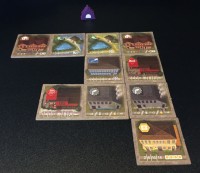
Ever since we first played Carcassonne many years ago we've been fans of tile-laying games. It's fun to start with a clear slate and build the board – countryside/city – as you go. Seeing your creation take shape throughout the game is just a lot of fun.
And the case of Between Two Cities, you're working on two different creations with two different partners. You may think shifting your focus back and forth between the two cities on each side of you would be a confusing head-scratcher. But it's not. It's simply fun.
We suppose you could take methodical time analyzing every possible play and outcome. But since you're not always sure what tiles are going to come next, you just have to take your best guess, place your building tiles and move on.
As such, Between Two Cities is more of a tactical game rather than one of strategy – doing the best with what you have on hand.
But that's not to say that it's completely devoid of strategy. Because your final city will be limited to a 4×4 grid of 16 building tiles, you simply can't do everything you'd like to do. Sure it would be nice to be able to get a lot of tiles of each type, but you just don't have room for them all. So you have to choose what to focus on for each of your neighboring cities. Maybe you'll try to get the most points out of factories in one city and focus on offices and taverns in the other.
Simultaneous Play and Interaction
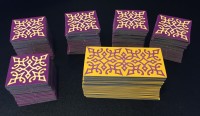
Downtime during a game with many players can be a real drag. Waiting for other players (especially brothers and sisters) to take their turn can often test a player's patience.
On of the absolute best things about Between Two Cities is the simultaneous play.
Whether you're playing with 3 players or 7, the game last just as long. There's no downtime waiting for other players to take their turn because there aren't any turns.
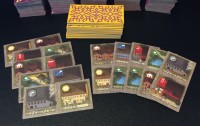
First everyone is looking at their hand of tiles and choosing which to keep at the same time. Once tiles are chosen, everyone is then talking with their neighboring players about where the best spots are for the tiles in their shared city.
After all, players are trying to score the most points they can with their shared city. The interaction of working cooperatively to get high scoring cities is a lot of fun.
So rather than sitting and waiting, players are actively engaged the whole time!
Unique Puzzle-like Scoring
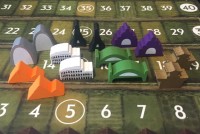
When we explain the unique scoring in Between Two Cities, people usually ask for us to repeat it. It's just so different that it takes new players a few seconds to process. It also adds a very unique spin to the city-building challenge.
You're working together with two neighboring players to score the highest you can with each city, but your final score will be the lower score of your two cities.
Thus, every player is puzzling out the best way to build their cities so they advance in a balanced manner. If you completely neglect one city in favor of the other, you'll lose terribly.
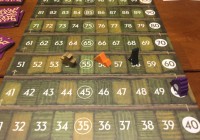
The combined puzzle-like nature of building your tile city and the unique scoring makes for a very fun time.
Solo Play
Between Two Cities also includes a way for the game to be played solo. Since there's a puzzle-like nature to the game, it makes sense that someone could enjoy the challenge of scoring certain point thresholds in such a game.
The Solo rules introduce 2 additional automated players. The structure looks like a 3-player game with 3 cities being built. However, because the additional players are like robots, there is a deck of cards that indicate how those pseudo-players will play their tiles.
In addition, there are slight changes to the scoring values for the city created between the two automated players. And that's the city the real player is competing against.
While I liked the idea of being able to play Between Two Cities in solo-mode, it fell very flat to me.
I'll give credit to the designer for creating a solo variant. But I now know solo-play of Between Two Cities isn't for me.
And that's perfectly fine, because the fun of Between Two Cities shines when building cities together with other players.
How does Between Two Cities score on our "Let's Play Again" game meter?
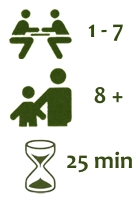 Between Two Cities scores high on our "let's play again" game meter. Because of the simultaneous play, simple decision-making, and all players being engaged the whole time, games seem to fly by.
Between Two Cities scores high on our "let's play again" game meter. Because of the simultaneous play, simple decision-making, and all players being engaged the whole time, games seem to fly by.
There's also virtually no set-up time for the game. So staring another game after one has just ended is almost a seamless process. Just reshuffle all the tiles and you're ready to go.
In addition, most of time, final scores are very close to one another. So calls for "one more!" almost seem inevitable.
Thanks Stonemaier Games for a very fun family board game!
The Game Boy Geek Video Review
If the description in the How to Play section above isn't enough to give you a picture of how the flow of the game works, check out The Game Boy Geek's video review of Between Two Cities. He does a great job showing how the game plays in detail.
Game Designer Between Two Cities
Source: https://www.theboardgamefamily.com/2016/02/between-two-cities-board-game-review/
Posted by: feltonocuslike84.blogspot.com

0 Response to "Game Designer Between Two Cities"
Post a Comment